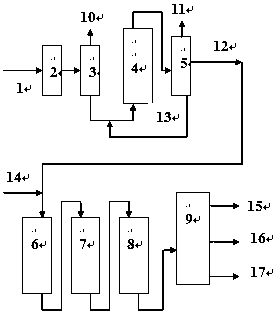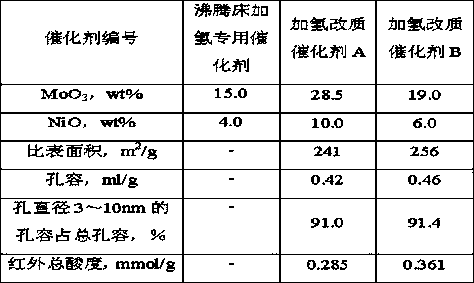Hydrogenation regeneration method of waste lubricating oil
A waste lubricating oil, hydrogenation regeneration technology, applied in the direction of lubricating composition, hydrogenation treatment process, petroleum industry, etc., can solve the problems of poor adaptability, ineffective utilization, mixed sources of waste lubricating oil, etc., to improve the operating life, The effect of reducing yield loss and utilizing high yield
- Summary
- Abstract
- Description
- Claims
- Application Information
AI Technical Summary
Problems solved by technology
Method used
Image
Examples
Embodiment approach
[0040] Such as figure 1 As shown, the process flow of the method of the present invention is as follows: first, the waste lubricating oil raw material 1 enters the pretreatment unit 2 for electric desalination operation, and removes trace water, inorganic chloride ions and sodium, calcium, magnesium, iron contained in the waste lubricating oil raw material Metal impurities, such as metal impurities, the raw material oil salt content after electric desalting treatment is required to be less than 3ppm. The material desalted by the pretreatment unit enters the flash tower 3, and after flashing, the light components at the top of the flash tower and the materials at the bottom of the tower are filtered and then enter the ebullating bed reactor 4 for hydrogenation pretreatment reaction, and the reaction processed products enter Separation and fractionation unit 5 to obtain gas, liquid fraction and residue; wherein the residue is circulated back to ebullated bed reactor 4 for proces...
Embodiment 1
[0063] Prepare 700 solid sodium aluminate to a concentration of 200gAl 2 o 3 / L concentrated sodium aluminate solution, then diluted to a concentration of 35gAl 2 o 3 / L sodium aluminate working solution (a), take SiO 2 28wt% sodium silicate solution, then diluted to a concentration of 150gSiO 2 / L sodium silicate working solution 2L (b). Take a 30L steel plastic tank, open the container valves containing (a) and (b) respectively, and ventilate and feed CO with a concentration of 45v% at the same time 2 Gas, set the flow rate of (a) and (b) so that the reaction time is 1 hour, and quickly adjust the CO 2 flow rate, keep the pH of the system at about 10.0, and the reaction temperature is 30°C. After the reaction of (a) and (b) is completed, stop feeding CO 2 , and then the ventilation was stable for 40 minutes, and the slurry was filtered and washed with 85°C deionized water until neutral. Dry at 120°C for 8 hours, crush and sieve to obtain amorphous silica-alumina GL. ...
Embodiment 2
[0065] Get 80g silicon aluminum GL, 30g modified Y zeolite (SiO 2 / Al 2 o 3 40, unit cell constant 2.432nm, infrared acidity 0.19mmol / g specific surface 866m 2 / g, pore volume 0.52ml / g) and 250g adhesive made by peptizing nitric acid and SB alumina, kneading, rolling, making extrudable paste, extruding into strips. Carrier A was obtained by drying at 110°C for 6 hours and calcining at 550°C for 4 hours. Then 80 g of A was impregnated with 200 ml of a Mo-Mi co-impregnation solution in excess for 2 hours, dried at 110° C. for 6 hours, and calcined at 500° C. for 4 hours to obtain hydrogenation upgrading catalyst A. The physical properties of the hydrogenation upgrading catalyst are shown in Table 2.
PUM
| Property | Measurement | Unit |
|---|---|---|
| specific surface area | aaaaa | aaaaa |
| specific surface area | aaaaa | aaaaa |
| pore size | aaaaa | aaaaa |
Abstract
Description
Claims
Application Information
 Login to View More
Login to View More - R&D
- Intellectual Property
- Life Sciences
- Materials
- Tech Scout
- Unparalleled Data Quality
- Higher Quality Content
- 60% Fewer Hallucinations
Browse by: Latest US Patents, China's latest patents, Technical Efficacy Thesaurus, Application Domain, Technology Topic, Popular Technical Reports.
© 2025 PatSnap. All rights reserved.Legal|Privacy policy|Modern Slavery Act Transparency Statement|Sitemap|About US| Contact US: help@patsnap.com



